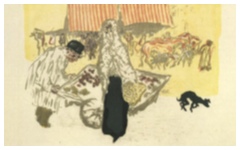Bonnard’s Woman with an Umbrella (1895)

Bonnard, Woman with an Umbrella from L'Album de la Revue Blance (1895) Lithograph
Click image to enlarge.
This simple design by Bonnard is not what it seems. Bonnard's wire-rimmed glasses were such an iconic feature of his face that viewers of his art should always be alert for circular or oval shapes. Here the umbrella's handle, more circular than most, might represent his eye. If so, the contour of the woman's black dress below could be his "face." Indeed the sensation that we are looking at a facial profile in the dress is so strong that the umbrella, on second thoughts, must be his "mind's eye" above his real one.1
Click next thumbnail to continue

Left: Detail of Bonnard's Woman with an Umbrella (1895)
Center: Photograph of Bonnard, c. 1890
Right: Diagram of Bonnard's Woman with an Umbrella
Click image to enlarge.
I have not yet found an image of Bonnard in profile. However, compared to this slightly earlier photograph, one can sense the similarity. As I see it, the woman is Bonnard's alter ego with her far hand so loosely defined that it resembles a brush. She is emerging from her creator's androgynous mind, like Athena from Zeus' head, with an umbrella. Why an umbrella? Lithographic stones are washed with water so, in Bonnard's mind, she is being careful not to slip on the stone's wet surface during the making of this actual lithograph.
More Works by Bonnard
Notes:
1. Dario Gamboni noted the nose and mouth in his book on ambiguous images but, in not recognizing the umbrella handle as the eye, he failed to see the profile as Bonnard's own face. Gamboni, Potential Images: Ambiguity and Indeterminancy in Modern Art (London: Reaktion Books) 2002, p. 100
Original Publication Date on EPPH: 23 Oct 2011. | Updated: 0. © Simon Abrahams. Articles on this site are the copyright of Simon Abrahams. To use copyrighted material in print or other media for purposes beyond 'fair use', you must obtain permission from the copyright owner. Websites may link to this page without permission (please do) but may not reproduce the material on their own site without crediting Simon Abrahams and EPPH.



